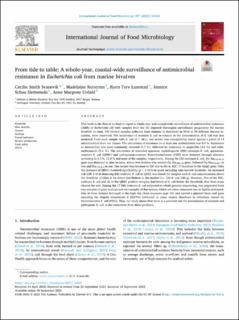| dc.contributor.author | Svanevik, Cecilie Smith | |
| dc.contributor.author | Norström, Madelaine | |
| dc.contributor.author | Lunestad, Bjørn Tore | |
| dc.contributor.author | Slettemeås, Jannice Schau | |
| dc.contributor.author | Urdahl, Anne Margrete | |
| dc.date.accessioned | 2023-11-08T09:32:46Z | |
| dc.date.available | 2023-11-08T09:32:46Z | |
| dc.date.created | 2023-10-22T13:11:38Z | |
| dc.date.issued | 2023 | |
| dc.identifier.citation | International journal of food microbiology. 2023, 407 . | en_US |
| dc.identifier.issn | 0168-1605 | |
| dc.identifier.uri | https://hdl.handle.net/11250/3101328 | |
| dc.description.abstract | This work is the first of its kind to report a whole-year and coastal-wide surveillance of antimicrobial resistance (AMR) of Escherichia coli with samples from the EU imposed Norwegian surveillance programme for marine bivalves. In total, 390 bivalve samples collected from January to December in 2016 at 59 different harvest locations, were examined. The occurrence of resistant E. coli in relation to the concentration of E. coli was also analysed. From each sample with E. coli (n = 261), one isolate was susceptibility tested against a panel of 14 antimicrobials from ten classes. The occurrence of resistance to at least one antimicrobial was 8.4 %. Resistance to tetracycline was most commonly detected (5.7 %), followed by resistance to ampicillin (4.6 %) and sulfamethoxazole (3.1 %). The occurrence of extended spectrum cephalosporin (ESC)-resistant E. coli, quinolone-resistant E. coli (QREC) and carbapenem-resistant Enterobacteriaceae (CRE) were detected through selective screening in 3.3 %, 12.8 % and none of the samples, respectively. Among the ESC-resistant E. coli, the blaCTX-M-15 gene was detected in nine isolates, where two isolates also carried the blaCMY-42 gene, followed by blaCTX-M-3 in two and blaCTX-M-1 in one. One isolate was resistant to ESC due to the n.-42C>T mutation in the AmpC gene. Only the presence of QREC clustered significantly (p < 0.013) in space including nine harvest locations. An increased risk (OR 9.4) of detecting ESC-resistant E. coli or QREC was found for samples with E. coli concentrations above the threshold of Class A for direct distribution to the market (i.e. 230 E. coli/100 g). However, five of the ESC-resistant E. coli and 26 of the QREC positive samples, had levels of E. coli below the threshold, thus from areas cleared for sale. Among the 17 ESC-resistant E. coli subjected to whole genome sequencing, two originated from two samples of great scallops and two samples of flat oysters, which are often consumed raw or lightly processed. One of these isolates belonged to the high-risk clone sequence type 131 and carried a plasmid born senB gene encoding the Shigella enterotoxin 2 (ShET2) attributed to cause watery diarrhoea in infections caused by Enteroinvasive E. coli (EIEC). Thus, our study shows that there is a potential risk for transmission of resistant and pathogenic E. coli to the consumers from these products. | en_US |
| dc.language.iso | eng | en_US |
| dc.title | From tide to table: A whole-year, coastal-wide surveillance of antimicrobial resistance in Escherichia coli from marine bivalves | en_US |
| dc.title.alternative | From tide to table: A whole-year, coastal-wide surveillance of antimicrobial resistance in Escherichia coli from marine bivalves | en_US |
| dc.type | Peer reviewed | en_US |
| dc.type | Journal article | en_US |
| dc.description.version | publishedVersion | en_US |
| dc.source.pagenumber | 8 | en_US |
| dc.source.volume | 407 | en_US |
| dc.source.journal | International journal of food microbiology | en_US |
| dc.identifier.doi | 10.1016/j.ijfoodmicro.2023.110422 | |
| dc.identifier.cristin | 2187333 | |
| cristin.ispublished | true | |
| cristin.fulltext | original | |
| cristin.qualitycode | 2 | |
